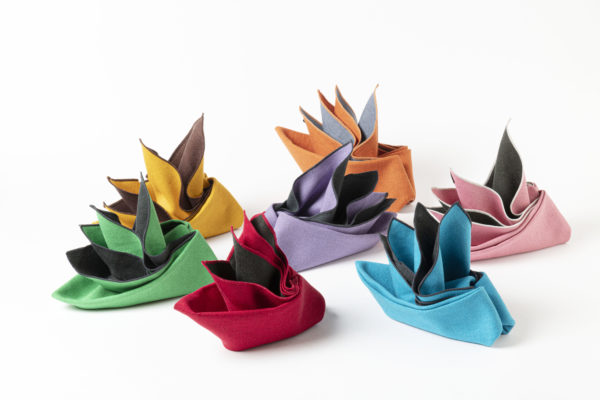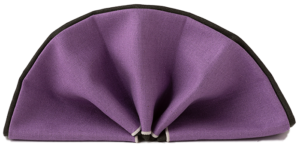Staining
Raku’s motivation for dyeing
Duxe Visages(二つの顔・両面染色)
This is what I was born in 1996 when I met Albert Moris, the planning director at FENDI New York, in New York.
He gave me the idea “Why do not you make a napkin? The future world will look towards” food culture “in the future”
At that time, what inspired me in my head, if I make a napkin, I will dye it on both sides.
Napkins are western culture.
There is chess in Western games.
I dyed the back side with the pattern of the board, dyed the pattern of the piece and folding it, I made the image of the napkin with the play where the piece comes out on the board.
And by using patterns in Japan, including one that made use of Japanese dyeings (Crimped pattern · family crest pattern etc), it means that one expression can be made.
There is a change in the textile world, and weaving and yarns are improving, not just as it was in the past.
Dyeing techniques should be improved as well.
There is double-sided dyeing in the world of dyed dyed, and still a part still remains.
If you can make use of its double-sided dyeing on what you use everyday, you can know the goodness of harmony and the goodness of the Western world.
Time has flowed, Japanese architecture, lifestyle has also changed. The futon becomes bed, the Japanese style table is western style table and chair, the sliding door to curtain, the house is narrower than the old days, and the atmosphere where many sums and westerns are fused is required.
If one side is a Japanese pattern and one side is a Western pattern, depending on the occasion, you can create two styles in the same place and enjoy the different atmosphere.
Incorporate dyeing into living as well as clothing. It will bring peace of mind to everyday life. The things you do not mind even in that place, and the world that you feel a little luxury, you will soak in a pleasant satisfaction, when you meet an object that brings such comfort the joy will be big.
When inviting me to meet with people, I am confident that Duxe Visages (two facial and two-sided dyeing) will surely be loved by the people of the world when I make an unexpected visit, not only in Japan but also in overseas markets ” We have started to make textile products.
Dye cloth tweets
“Look into my hidden place”
“Even though it is a piece of cloth, the front and back are different”
”Raku – tone ‘s dye dyed a piece of fabric on the front and back with Yuzen’ s method”
The color of the ancient Japan and the color of the present age,
Dyed in natural materials such as hemp and cotton,
I want you to feel kindness and warmth
I hope that you enjoy Japan’s wonderful ‘IKI’ ‘WABI · SABI’ from the bottom of your heart.
Look into my hidden place Even though it is a piece of cloth, the front and back are different
Raku – tone ‘s dye dyed a piece of fabric on the front and back with Yuzen’ s method
The color of the ancient Japan and the color of the present age,
Dyed in natural materials such as hemp and cotton,
I want you to feel kindness and warmth
I hope that you enjoy Japan’s wonderful ‘IKI’ ‘WABI · SABI’ from the bottom of your heart.
Characters and attitudes are brilliant,
Person with natural color incense
People with 『IKI』 understand the society of men, women, and entertainers, so you can solve the problem.
“Wabisabi” is a word expressing beauty and a unique Japanese artistic view
“Wabi” is a word expressing negative feelings such as depression, non-grief and depression,
“Rust” is a word that expresses negative appearance such as old, faded, or shaky.
Both are words expressing negative emotions,
The fact that the interwoven changes of what are generally regarded as deterioration is “rust” that is unique and beautiful,
It is used as a expression expressing a unique aesthetic sense of Japan, with the mind trying to accept and respond to the numbness as “Wabi”.
Currently it is often used as “Wabisabi” at once, it is thought to represent calm and lonesome feeling in the simplicity, and the point of darkness.




